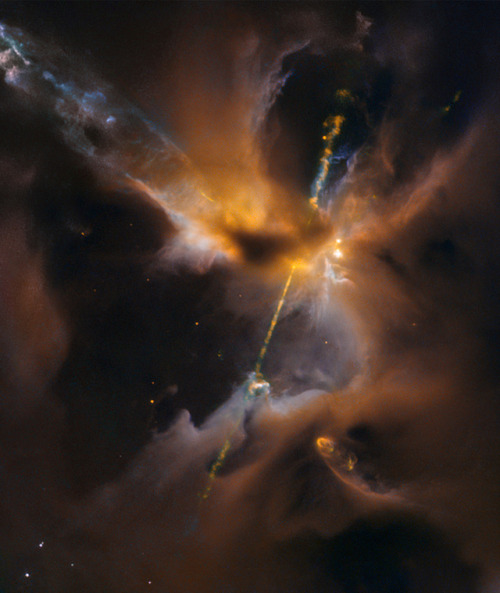Composed Of Gas And Dust, The Pictured Pillar Resides In A Tempestuous Stellar Nursery Called The Carina

Composed of gas and dust, the pictured pillar resides in a tempestuous stellar nursery called the Carina Nebula, located 7500 light-years away in the southern constellation of Carina.
Credit: NASA, ESA and the Hubble SM4 ERO Team
More Posts from Xyhor-astronomy and Others

ON THIS DAY: An impressive impact crater on Mars, observed by NASA’s Mars Reconnaissance Orbiter, November 19, 2013. (NASA)


Solar ❤

Meteor impact craters of the world

False color image of Uranus taken with the Hale Telescope and the Palomar Observatory. The rings are the red pieces.
Image credit: Palomar Observatory & Hale telescope

The Space Shuttle Challenger at a foggy Cape Canaveral, 1984.
(NASA/Department of Defense)

Hubble Sees the Force Awakening in a Newborn Star
This celestial lightsaber does not lie in a galaxy far, far away, but rather inside our home galaxy, the Milky Way. It’s inside a turbulent birthing ground for new stars known as the Orion B molecular cloud complex, located 1,350 light-years away.
In the center of the image, partially obscured by a dark, Jedi-like cloak of dust, a newborn star shoots twin jets out into space as a sort of birth announcement to the universe
Credit: NASA/ESA
A new detector can use neutrinos to help us take a peek inside Earth!
The dusty, star-forming galaxy took shape in the first billion years after the Big Bang and is likely to be one of the first galaxies to ever form, says Min Yun, astrophysicist of the University of Massachusetts Amherst.

-
 iwannarunaway-13 liked this · 3 weeks ago
iwannarunaway-13 liked this · 3 weeks ago -
 zurgy-space reblogged this · 11 months ago
zurgy-space reblogged this · 11 months ago -
 zurgy liked this · 11 months ago
zurgy liked this · 11 months ago -
 demichrising liked this · 1 year ago
demichrising liked this · 1 year ago -
 ravexandxlust liked this · 1 year ago
ravexandxlust liked this · 1 year ago -
 exhausted-asterism reblogged this · 2 years ago
exhausted-asterism reblogged this · 2 years ago -
 squidsandthings liked this · 2 years ago
squidsandthings liked this · 2 years ago -
 dildoteamtaskforce reblogged this · 3 years ago
dildoteamtaskforce reblogged this · 3 years ago -
 wolfsong-the-bloody-beast reblogged this · 3 years ago
wolfsong-the-bloody-beast reblogged this · 3 years ago -
 pipuisci reblogged this · 3 years ago
pipuisci reblogged this · 3 years ago -
 reasonpeason liked this · 3 years ago
reasonpeason liked this · 3 years ago -
 kenny-wind-yt reblogged this · 3 years ago
kenny-wind-yt reblogged this · 3 years ago -
 kenny-wind-yt liked this · 3 years ago
kenny-wind-yt liked this · 3 years ago -
 luthiens-star liked this · 3 years ago
luthiens-star liked this · 3 years ago -
 farmerbrown liked this · 3 years ago
farmerbrown liked this · 3 years ago -
 cs81sstuff liked this · 3 years ago
cs81sstuff liked this · 3 years ago -
 basarab liked this · 3 years ago
basarab liked this · 3 years ago -
 crimson52 liked this · 3 years ago
crimson52 liked this · 3 years ago -
 senseitophat liked this · 3 years ago
senseitophat liked this · 3 years ago -
 megagata liked this · 3 years ago
megagata liked this · 3 years ago -
 spacefrog23 liked this · 3 years ago
spacefrog23 liked this · 3 years ago -
 randybr3001 liked this · 3 years ago
randybr3001 liked this · 3 years ago -
 queen-of-the-underworlds liked this · 3 years ago
queen-of-the-underworlds liked this · 3 years ago -
 stridersarchive reblogged this · 3 years ago
stridersarchive reblogged this · 3 years ago -
 stridersarchive liked this · 3 years ago
stridersarchive liked this · 3 years ago -
 robbyxl89 liked this · 3 years ago
robbyxl89 liked this · 3 years ago -
 kapitaali liked this · 3 years ago
kapitaali liked this · 3 years ago -
 marty101sblog reblogged this · 3 years ago
marty101sblog reblogged this · 3 years ago -
 marty101sblog liked this · 3 years ago
marty101sblog liked this · 3 years ago -
 mardy-numb liked this · 3 years ago
mardy-numb liked this · 3 years ago -
 somebodysmama reblogged this · 3 years ago
somebodysmama reblogged this · 3 years ago -
 somebodysmama liked this · 3 years ago
somebodysmama liked this · 3 years ago -
 eljuicy reblogged this · 3 years ago
eljuicy reblogged this · 3 years ago -
 jadedmisfits reblogged this · 3 years ago
jadedmisfits reblogged this · 3 years ago -
 c0smicdrift3r reblogged this · 3 years ago
c0smicdrift3r reblogged this · 3 years ago -
 black---dahlia liked this · 3 years ago
black---dahlia liked this · 3 years ago -
 psychedelicprincess333 reblogged this · 3 years ago
psychedelicprincess333 reblogged this · 3 years ago -
 afatalheat reblogged this · 3 years ago
afatalheat reblogged this · 3 years ago
For more content, Click Here and experience this XYHor in its entirety!Space...the Final Frontier. Let's boldly go where few have gone before with XYHor: Space: Astronomy & Spacefaring: the collection of the latest finds and science behind exploring our solar system, how we'll get there and what we need to be prepared for!
128 posts